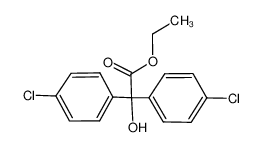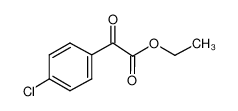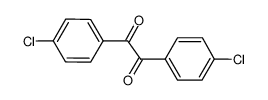1.Identification
1.1 GHS Product identifier
| Product name | chlorobenzilate |
|---|
1.2 Other means of identification
| Product number | - |
|---|---|
| Other names | Akar |
1.3 Recommended use of the chemical and restrictions on use
| Identified uses | For industry use only. Chlorobenzilate was primarily used as a nonsystemic pesticide in spider and mite control, usually against phytophagus mites on citrus and deciduous fruit trees. All uses have been canceled.) |
|---|---|
| Uses advised against | no data available |
1.4 Supplier's details
| Company | MOLBASE (Shanghai) Biotechnology Co., Ltd. |
|---|---|
| Address | Floor 4 & 5, Building 12, No. 1001 North Qinzhou Road, Xuhui District, Shanghai, China |
| Telephone | +86(21)64956998 |
| Fax | +86(21)54365166 |
1.5 Emergency phone number
| Emergency phone number | +86-400-6021-666 |
|---|---|
| Service hours | Monday to Friday, 9am-5pm (Standard time zone: UTC/GMT +8 hours). |
2.Hazard identification
2.1 Classification of the substance or mixture
Acute toxicity - Oral, Category 4
Hazardous to the aquatic environment, short-term (Acute) - Category Acute 1
Hazardous to the aquatic environment, long-term (Chronic) - Category Chronic 1
2.2 GHS label elements, including precautionary statements
| Pictogram(s) |   |
|---|---|
| Signal word | Warning |
| Hazard statement(s) | H302 Harmful if swallowed H410 Very toxic to aquatic life with long lasting effects |
| Precautionary statement(s) | |
| Prevention | P264 Wash ... thoroughly after handling. P270 Do not eat, drink or smoke when using this product. P273 Avoid release to the environment. |
| Response | P301+P312 IF SWALLOWED: Call a POISON CENTER/doctor/…if you feel unwell. P330 Rinse mouth. P391 Collect spillage. |
| Storage | none |
| Disposal | P501 Dispose of contents/container to ... |
2.3 Other hazards which do not result in classification
none
3.Composition/information on ingredients
3.1 Substances
| Chemical name | Common names and synonyms | CAS number | EC number | Concentration |
|---|---|---|---|---|
| chlorobenzilate | chlorobenzilate | 510-15-6 | none | 100% |
4.First-aid measures
4.1 Description of necessary first-aid measures
General advice
Consult a physician. Show this safety data sheet to the doctor in attendance.
If inhaled
Fresh air, rest. Refer for medical attention.
In case of skin contact
Remove contaminated clothes. Rinse and then wash skin with water and soap.
In case of eye contact
First rinse with plenty of water for several minutes (remove contact lenses if easily possible), then refer for medical attention.
If swallowed
Rinse mouth. Give one or two glasses of water to drink. Do NOT induce vomiting. Refer for medical attention .
4.2 Most important symptoms/effects, acute and delayed
SYMPTOMS: Symptoms of exposure to this compound include central nervous system stimulation, vomiting, diarrhea, paresthesia, excitement, giddiness, fatigue, tremors, convulsions, pulmonary edema, hypothermia, headache, loss of appetite muscular weakness, apprehensive mental state, myocardial toxicity, impotence, infertility and coma. It may also cause hyperexcitability, narcosis, central nervous system depression, kidney damage and liver damage. Other symptoms include muscle pains, ataxia, mild delirium and fever. It may also cause skin irritation. Testicular damage can occur. ACUTE/CHRONIC HAZARDS: This compound is moderately toxic by inhalation. It may be absorbed through the respiratory tract, gastrointestinal tract and skin. It may cause irritation of the skin. When heated to decomposition it emits toxic fumes of chlorides.
4.3 Indication of immediate medical attention and special treatment needed, if necessary
Skin decontamination. Wash skin with soap and water ... . Eye contamination should be removed by prolonged flushing of the eye with copious amounts of clean water or saline. If irritation persists, specialized medical treatment should be obtained.
5.Fire-fighting measures
5.1 Extinguishing media
Suitable extinguishing media
Use dry chemical, carbon dioxide, or alcohol foam extinguishers. Vapors are heavier than air and will collect in low areas. Vapors may travel long distances to ignition sources and flashback ...
5.2 Specific hazards arising from the chemical
Flash point data for this chemical are not available; however, it is probably combustible.
5.3 Special protective actions for fire-fighters
Wear self-contained breathing apparatus for firefighting if necessary.
6.Accidental release measures
6.1 Personal precautions, protective equipment and emergency procedures
Use personal protective equipment. Avoid dust formation. Avoid breathing vapours, mist or gas. Ensure adequate ventilation. Evacuate personnel to safe areas. Avoid breathing dust. For personal protection see section 8.
6.2 Environmental precautions
Personal protection: P2 filter respirator for harmful particles. Do NOT let this chemical enter the environment. Sweep spilled substance into covered containers. If appropriate, moisten first to prevent dusting. Carefully collect remainder. Then store and dispose of according to local regulations.
6.3 Methods and materials for containment and cleaning up
SRP: Wastewater from contaminant suppression, cleaning of protective clothing/equipment, or contaminated sites should be contained and evaluated for subject chemical or decomposition product concentrations. Concentrations shall be lower than applicable environmental discharge or disposal criteria. Alternatively, pretreatment and/or discharge to a POTW is acceptable only after review by the governing authority. Due consideration shall be given to remediation worker exposure (inhalation, dermal and ingestion) as well as fate during treatment, transfer and disposal. If it is not practicable to manage the chemical in this fashion, it must meet Hazardous Material Criteria for disposal.
7.Handling and storage
7.1 Precautions for safe handling
Avoid contact with skin and eyes. Avoid formation of dust and aerosols. Avoid exposure - obtain special instructions before use.Provide appropriate exhaust ventilation at places where dust is formed. For precautions see section 2.2.
7.2 Conditions for safe storage, including any incompatibilities
Separated from food and feedstuffs, strong oxidants, bases and strong acids.PRECAUTIONS FOR "CARCINOGENS": Storage site should be as close as practicable to lab in which carcinogens are to be used, so that only small quantities required for ... expt need to be carried. Carcinogens should be kept in only one section of cupboard, an explosion-proof refrigerator or freezer (depending on chemicophysical properties ...) that bears appropriate label. An inventory ... should be kept, showing quantity of carcinogen & date it was acquired ... Facilities for dispensing ... should be contiguous to storage area. /Chemical Carcinogens/
8.Exposure controls/personal protection
8.1 Control parameters
Occupational Exposure limit values
no data available
Biological limit values
no data available
8.2 Appropriate engineering controls
Handle in accordance with good industrial hygiene and safety practice. Wash hands before breaks and at the end of workday.
8.3 Individual protection measures, such as personal protective equipment (PPE)
Eye/face protection
Safety glasses with side-shields conforming to EN166. Use equipment for eye protection tested and approved under appropriate government standards such as NIOSH (US) or EN 166(EU).
Skin protection
Wear impervious clothing. The type of protective equipment must be selected according to the concentration and amount of the dangerous substance at the specific workplace. Handle with gloves. Gloves must be inspected prior to use. Use proper glove removal technique(without touching glove's outer surface) to avoid skin contact with this product. Dispose of contaminated gloves after use in accordance with applicable laws and good laboratory practices. Wash and dry hands. The selected protective gloves have to satisfy the specifications of EU Directive 89/686/EEC and the standard EN 374 derived from it.
Respiratory protection
Wear dust mask when handling large quantities.
Thermal hazards
no data available
9.Physical and chemical properties
| Physical state | COLORLESS LIQUID W/ETHER LIKE ODOR |
|---|---|
| Colour | Colorless solid (pure) |
| Odour | no data available |
| Melting point/ freezing point | 37ºC |
| Boiling point or initial boiling point and boiling range | 452.3ºC at 760 mmHg |
| Flammability | Combustible. Gives off irritating or toxic fumes (or gases) in a fire. Liquid formulations containing organic solvents may be flammable. |
| Lower and upper explosion limit / flammability limit | no data available |
| Flash point | 227.4ºC |
| Auto-ignition temperature | no data available |
| Decomposition temperature | no data available |
| pH | no data available |
| Kinematic viscosity | no data available |
| Solubility | less than 0.1 mg/mL at 22.22°C |
| Partition coefficient n-octanol/water (log value) | log Kow = 4.74 |
| Vapour pressure | 2.2e-06 mm Hg at 20°C |
| Density and/or relative density | 1.332 g/cm3 |
| Relative vapour density | no data available |
| Particle characteristics | no data available |
10.Stability and reactivity
10.1 Reactivity
no data available
10.2 Chemical stability
Stable under recommended storage conditions.
10.3 Possibility of hazardous reactions
This chemical may burn but does not easily ignite.CHLOROBENZILATE is hydrolyzed by alkalis and strong acids. Incompatible with lime .
10.4 Conditions to avoid
no data available
10.5 Incompatible materials
Strong acids , strong bases, lime.
10.6 Hazardous decomposition products
Emits toxic fumes of /hydrogen chloride/ when heated to decomposition.
11.Toxicological information
Acute toxicity
- Oral: LD50 Rat oral 2784-3880 mg/kg
- Inhalation: no data available
- Dermal: LD50 Rabbit percutaneous >10,000 mg/kg
Skin corrosion/irritation
no data available
Serious eye damage/irritation
no data available
Respiratory or skin sensitization
no data available
Germ cell mutagenicity
no data available
Carcinogenicity
The Carcinogen Assessment Group in EPA's Research and Development Office has evaluated ethyl 4,4-dichlorobenzilate for carcinogenicity. According to their analysis, the weight of evidence for ethyl 4,4-dichlorobenzilate is group B2, which is based on inadequate evidence in humans and sufficient evidence in animals. As a group B2 chemical, ethyl 4,4-dichlorobenzilate is considered a probable human carcinogen.
Reproductive toxicity
No information is available on the reproductive or developmental effects of chlorobenzilate in humans. Injury to the sperm and atrophy of the testes have been observed in rats exposed to chlorobenzilate in their diet. Teratogenic effects were not observed in the offspring of rats exposed to chlorobenzilate in the diet or in rabbits exposed by gavage.
STOT-single exposure
no data available
STOT-repeated exposure
no data available
Aspiration hazard
no data available
12.Ecological information
12.1 Toxicity
- Toxicity to fish: LC50; Species: Oncorhynchus mykiss (Rainbow trout, weight 0.8g); Conditions: freshwater, static, 13°C, pH 7.1, hardness 44 mg/L CaCO3; Concentration: 750 ug/L for 24 hr /95.5% purity, technical material
- Toxicity to daphnia and other aquatic invertebrates: no data available
- Toxicity to algae: no data available
- Toxicity to microorganisms: no data available
12.2 Persistence and degradability
AEROBIC: The rate at which chlorobenzilate degrades in microbial growth media increases when citrate is incorporated(1). This may be due to a reductive decarboxylation process that the citrate stimulates(1). The half-life of chlorobenzilate in two fine sandy soils was estimated to be 1.5-5 weeks following application of 0.5-1.0 ppm; removal was probably microbial(2). It is decarboxylated to 4,4'-dichlorobenzophenone by a yeast isolated from insecticide treated soil under anaerobic conditions(3,4). In 22 days, 40, 29, and 39% of the (14)C-ring-labeled chlorobenzilate added to sediment-free water samples from 3 fresh water lakes was converted to organic products; no (14)CO2 evolution was detected(5). Addition of sediment to the water samples from the three lakes gave (14)CO2 yields 3.6, 0.0, and 18.3%(5). Chlorobenzilate was metabolized in water from another freshwater lake only when glucose and inorganic nutrients were added and mineralized to (14)CO2 only when sediment was also added to the water(5). Chlorobenzilate, present at 100 mg/L, reached 0% of its theoretical BOD in 4 weeks using an activated sludge inoculum at 30 mg/L in the Japanese MITI test(6). Half-lives for chlorobenzilate in Lukang silty clay loam and Pincheng clay ranged from 15.1 days at 10°C to 10.8 days at 25°C; and 169.1 days at 10°C to 29.5 days at 25°C, respectively(7).
12.3 Bioaccumulative potential
Measured BCF values for carp (Cyprinus carpio) ranged from 224 to 586 and 256 to 709 at concentrations of 20 ug/L and 2 ug/L, respectively(1). According to a classification scheme(2), these BCFs suggest the potential for bioconcentration in aquatic organisms is high(SRC).
12.4 Mobility in soil
The Koc of chlorobenzilate is estimated as 1,500(SRC), using a log Kow of 4.74(1) and a regression-derived equation(2). According to a classification scheme(3), this estimated Koc value suggests that chlorobenzilate is expected to have low mobility in soil. Kd values of 26 and 7.6 have been reported for Lukang and Pincheng soils, respectively, at 20°C; at 40°C, the Kd values reported were 41 and 5.3, respectively(4).
12.5 Other adverse effects
no data available
13.Disposal considerations
13.1 Disposal methods
Product
The material can be disposed of by removal to a licensed chemical destruction plant or by controlled incineration with flue gas scrubbing. Do not contaminate water, foodstuffs, feed or seed by storage or disposal. Do not discharge to sewer systems.
Contaminated packaging
Containers can be triply rinsed (or equivalent) and offered for recycling or reconditioning. Alternatively, the packaging can be punctured to make it unusable for other purposes and then be disposed of in a sanitary landfill. Controlled incineration with flue gas scrubbing is possible for combustible packaging materials.
14.Transport information
14.1 UN Number
| ADR/RID: UN1593 | IMDG: UN1593 | IATA: UN1593 |
14.2 UN Proper Shipping Name
| ADR/RID: DICHLOROMETHANE |
| IMDG: DICHLOROMETHANE |
| IATA: DICHLOROMETHANE |
14.3 Transport hazard class(es)
| ADR/RID: 6.1 | IMDG: 6.1 | IATA: 6.1 |
14.4 Packing group, if applicable
| ADR/RID: III | IMDG: III | IATA: III |
14.5 Environmental hazards
| ADR/RID: yes | IMDG: yes | IATA: yes |
14.6 Special precautions for user
no data available
14.7 Transport in bulk according to Annex II of MARPOL 73/78 and the IBC Code
no data available
15.Regulatory information
15.1 Safety, health and environmental regulations specific for the product in question
| Chemical name | Common names and synonyms | CAS number | EC number |
|---|---|---|---|
| chlorobenzilate | chlorobenzilate | 510-15-6 | none |
| European Inventory of Existing Commercial Chemical Substances (EINECS) | Listed. | ||
| EC Inventory | Listed. | ||
| United States Toxic Substances Control Act (TSCA) Inventory | Listed. | ||
| China Catalog of Hazardous chemicals 2015 | Listed. | ||
| New Zealand Inventory of Chemicals (NZIoC) | Not Listed. | ||
| Philippines Inventory of Chemicals and Chemical Substances (PICCS) | Not Listed. | ||
| Vietnam National Chemical Inventory | Not Listed. | ||
| Chinese Chemical Inventory of Existing Chemical Substances (China IECSC) | Not Listed. | ||
16.Other information
Information on revision
| Creation Date | Aug 13, 2017 |
|---|---|
| Revision Date | Aug 13, 2017 |
Abbreviations and acronyms
- CAS: Chemical Abstracts Service
- ADR: European Agreement concerning the International Carriage of Dangerous Goods by Road
- RID: Regulation concerning the International Carriage of Dangerous Goods by Rail
- IMDG: International Maritime Dangerous Goods
- IATA: International Air Transportation Association
- TWA: Time Weighted Average
- STEL: Short term exposure limit
- LC50: Lethal Concentration 50%
- LD50: Lethal Dose 50%
- EC50: Effective Concentration 50%
References
- IPCS - The International Chemical Safety Cards (ICSC), website: http://www.ilo.org/dyn/icsc/showcard.home
- HSDB - Hazardous Substances Data Bank, website: https://toxnet.nlm.nih.gov/newtoxnet/hsdb.htm
- IARC - International Agency for Research on Cancer, website: http://www.iarc.fr/
- eChemPortal - The Global Portal to Information on Chemical Substances by OECD, website: http://www.echemportal.org/echemportal/index?pageID=0&request_locale=en
- CAMEO Chemicals, website: http://cameochemicals.noaa.gov/search/simple
- ChemIDplus, website: http://chem.sis.nlm.nih.gov/chemidplus/chemidlite.jsp
- ERG - Emergency Response Guidebook by U.S. Department of Transportation, website: http://www.phmsa.dot.gov/hazmat/library/erg
- Germany GESTIS-database on hazard substance, website: http://www.dguv.de/ifa/gestis/gestis-stoffdatenbank/index-2.jsp
- ECHA - European Chemicals Agency, website: https://echa.europa.eu/


















-
-

-
-
-

-
-
-

-
-
-

-
-
-

-
-
-

-
More Suppliers>>Henan Coreychem Co.,Ltd
CHINA
Purity: 98%
Lead Time: 3 Day(s)
Price: Min $1 /g
CHINA
Purity: 99%
Lead Time: 3 Day(s)
Price: Min $100 /kg
Saan Chemical Technology (Shanghai) Co., Ltd.
CHINA
Purity: 96%
Lead Time: 1 Day(s)
Price: Min $96.33 /mg
Chengdu SinoStandards Bio-Tech Co.,Ltd.
CHINA
Purity: 98%
Lead Time: 7 Day(s)
Price: -
Tianjin Xima Technology Co., Ltd.
CHINA
Purity: 96%
Lead Time: 7 Day(s)
Price: -
Beijing Huaerbo Technology Co., Ltd.
CHINA
Purity: 95%
Lead Time: 0 Day(s)
Price: -